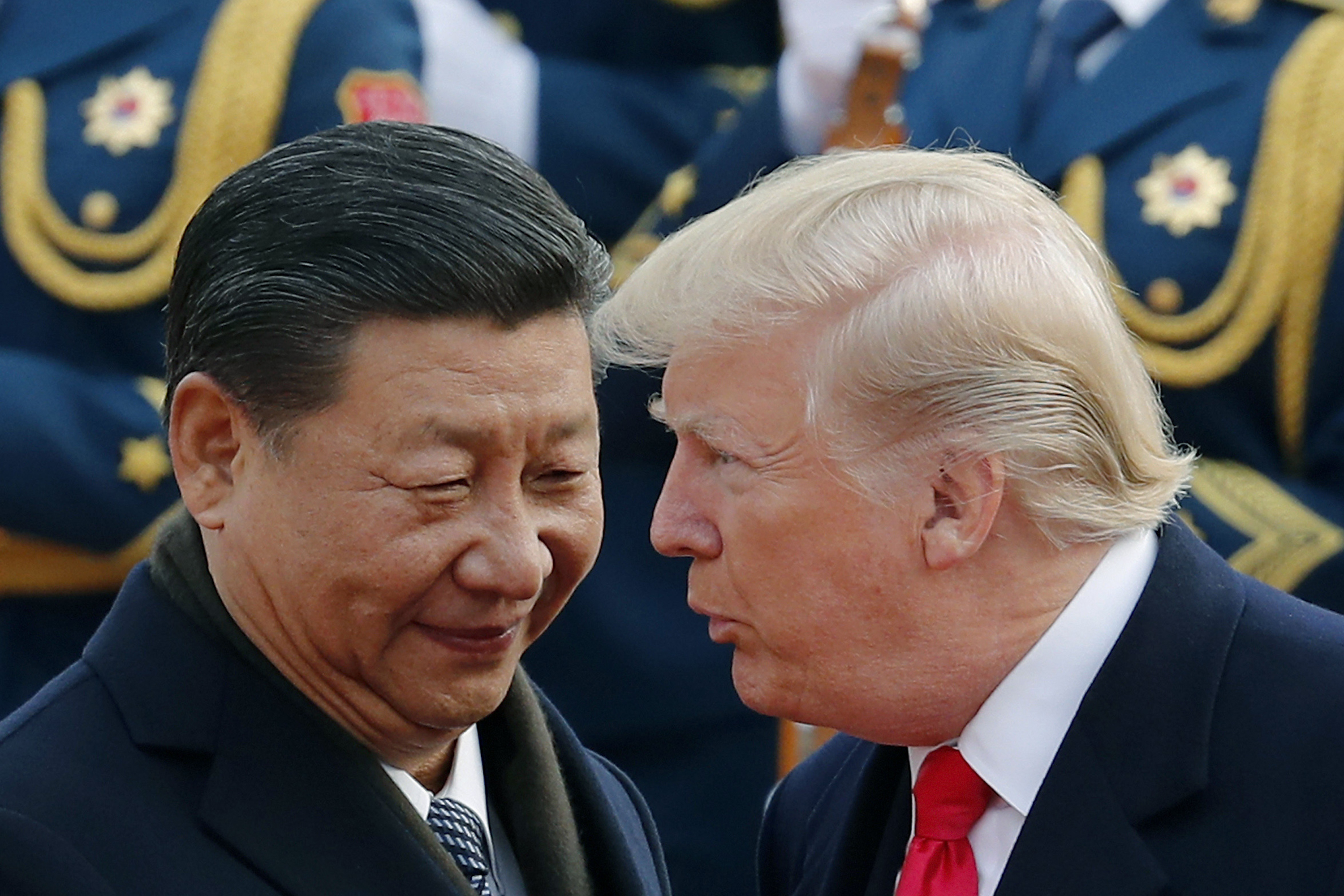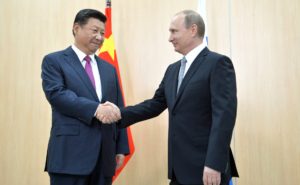Trump’s Trade Policy Is Accelerating America’s Decline
The president's fervently nationalist agenda has not only hurt our closest allies but undermined multilateral efforts to contain China. Chinese President Xi Jinping and Donald Trump. (Andy Wong / AP)
Chinese President Xi Jinping and Donald Trump. (Andy Wong / AP)
The United States has increased tariffs on $200 billion worth of Chinese products to 25 percent, and Beijing has responded in kind on $60 billion worth of American goods. More tit for tat appears to be on the way: the Trump administration is now openly deliberating whether to impose additional tariffs on a further $325 billion of Chinese goods exported to the United States. National security concerns are also being increasingly invoked: Not only is Huawei, the Chinese telecommunications group, already largely shut out of selling its products in the U.S. domestic market, but Trump is also now taking steps to ban the sale of U.S.-made components to Huawei as well. What was once a mere trade skirmish, therefore, appears to be metastasizing into Cold War 2.0.
This creates a conundrum for the Trump administration: Beijing is increasingly viewed by many countries as an economic rival or a security threat to be contained, rather than a collaborative trade partner to be accommodated. But the president’s “America First” trade policy is undermining broader multilateral efforts to contain China because Trump’s incessant focus on reducing his country’s bilateral trade deficit with Beijing means diverting Chinese purchases away from other trade counterparties.
That means, for example, China buying more U.S. cars made on American soil than, say, German ones, more U.S. soybeans than Brazilian, or more U.S. semiconductors than Japanese or South Korean ones, all designed to help reduce the bilateral deficit. This sort of a trade deal, however, is clearly not in the interests of the EU, Brazil, Japan, or Southeast Asia, and is making them averse to collaborating with the United States with regard to any Chinese security concerns they might share (which they do), especially when one considers that the basis for the West’s successful containment strategy against the former Soviet Union was that it was both collaborative and multilateral in scope.
Semiconductors are a perfect case in point to highlight the new contradiction. If Trump bans the export of U.S.-made semis to Huawei (he has now offered a temporary 90-day waiver), then the latter will naturally gravitate toward buying them from other countries. In fact, the Sino-U.S. trade dispute is just one of many growing points of friction between the U.S. and its traditional allies. Many are increasingly ignoring Trump, and competing for Chinese markets or investment (as the Italians have recently done in response to Beijing’s “Belt and Road Initiative”).
The Sino-U.S. dispute throws up other challenges for the administration: Tariffs are certainly effective as an attention-getting mechanism. But if the goal is ultimately to encourage more jobs at home, they will be ineffective if unaccompanied by a national industrial policy that focuses on American re-industrialization in order to create skilled, high-paying private sector jobs capable of profitably supporting workers with solid middle-class incomes. A corollary is that a national development policy must be geared toward jobs that reflect the needs of the 21st-century economy, rather than nostalgically working to sustain industries that may be headed toward obsolescence, like steel or even fossil fuels.
Many share the president’s belief that a harder line on Chinese trade is necessary. This reflects a growing loss of faith (even among those formerly well-disposed to Beijing) that the country’s market reforms will inevitably lead to multi-party liberal democracy, along with mounting skepticism that free trade and commercial co-dependence can displace military rivalry (a similar historic miscalculation was made before World War I).
But support for the president’s current stance, particularly from Democrats, is conditionally tied to the embrace of a more activist form of state industrial policy to ensure that American workers derive maximum benefit from the reverse engineering of existing “Chimerica” supply chains. And that, argues Professor Michael Lind, “means adequate and permanent production on U.S. soil, not just innovation in America and production elsewhere.” This means some combination of managed trade, along with national industrial policy.
Managed trade, which prioritizes concrete purchases of U.S. goods (as opposed to increased market access or structural changes to China’s economy), is not really new. Ronald Reagan pursued a similar policy against Japan during the 1980s. Nor is the idea of a national economic development strategy particularly contrary to American historical traditions. Since the days of Alexander Hamilton, industrialization and the concomitant role of the state have long been viewed as the joint basis of modern military power and prosperity by both major parties, whether the president was a Republican like Lincoln or Eisenhower, or a Democrat such as FDR or JFK.
It is only with the rise of multinational industry in the past few decades where the notion has taken hold that the state should limit its role in economic development. Borders have come second to measures of growth and corporate profitability. When there has been greater growth potential with policies that go across borders, the policies generally got the green light, even at a cost of eroding America’s homegrown manufacturing base. As industry became even more profitable when it went offshore, the focus for staying on top of the world’s economic food chain shifted—principally in the fields of advanced research in the fields of computing, biology and of course, military and space.
But Americans themselves often did not experience the benefits of these shifts as more and more industry moved offshore. International Monetary Fund (IMF) and World Bank loans ensured that the developing world would increasingly depend on Western agriculture to feed itself, Western engineering expertise to supply energy infrastructure, and Western finance centers to manage—and leverage—their economies. The muscle memory of state involvement in industry at this point is a matter of bailouts and buyouts. What remains of the old state-level involvement in national economic affairs has evolved into a “Washington Consensus” that engages in a more limited government role: Modest incentives and subsidies to avoid sudden and sharp economic convulsions. A 25-year decline in manufacturing, rather than all at once.
Until the latest disruption on trade, Wall Street and the markets had come to believe Trump would get a trade deal with China that promised increased access to Beijing’s domestic market (e.g., the credit card companies and the U.S. rating agencies), but not much in the way of a changed status quo. One of the reasons why the president may have pulled back from this kind of an agreement is that expanding U.S. corporate access to China’s domestic markets actually deepens “Chimerica” integration, rather than disrupting it and bringing much industry back to the United States. American blue-collar workers (a growing Trump constituency) will neither benefit from a “status quo plus” arrangement, nor is that kind of a deal consistent with the growing belief among Trump’s advisers that Beijing constitutes a growing national security threat.
Which leads to one of the new dimensions of this trade war: it is occurring against a backdrop in which long-standing contradictions with regard to trade and national security concerns have finally collided. These tensions are not new, as Michael Lind has observed:
“Under presidents of both parties, the Pentagon drew up war plans against China while the Commerce Department blessed the offshoring by U.S.-based multinationals of much of America’s industrial base to Chinese soil. This combination of ‘containment’ and ‘engagement’ inspired a name that itself was a contradiction: ‘congagement.’”
Trump is attempting to unravel “congagement” via the embrace of a more nationalistic industrial policy. That means returning to “the time-tested and successful Hamiltonian industrial strategy of using whatever means are necessary—tariffs, subsidies, procurement, tax breaks, even overseas-development loans to countries that purchase U.S. manufactured exports—to ensure that strategic industries necessary to U.S. military power are introduced to America or remain here,” as Lind writes.
So with regard to China, this means exporting U.S. goods made on American soil. It therefore disrupts existing supply chains. It’s not free trade by any stretch, but the virtue of numerical targets is that they are actually easier to monitor and enforce than vague promises to respect intellectual property or eliminate state subsidies. Under a managed trade framework, if China does not meet its quota of American goods, then Trump could slap on new tariffs. For America’s trade nationalists, this sort of a deal also has the happy byproduct of undermining the multilateral trade framework established by the World Trade Organization because enforcement mechanisms are left in the hands of the two parties to the agreement. With regard to national security considerations, it means preserving domestic manufacturing capacity in “dual-use” industries important in both defense and civilian commerce.
But in resolving one contraction, Trump might well be introducing a new one. While managed trade might well dislocate many existing “Chimerica” supply chains, such disruption would likely come at the economic expense of America’s traditional allies in Europe, Japan, Taiwan and Korea. If Beijing were to accept specified quotas, it means some other country loses out. Not only will this likely prove unacceptable to China’s non-U.S. trade partners, but it will also further exacerbate widening divisions between the United States and its traditional allies, making coherent economic diplomacy against Beijing less likely (especially against a backdrop of rising national populist movements that have rendered problematic any idea of a united European response in a protracted rivalry with China). And if it comes against a backdrop of China viewed as a national security threat, Beijing itself has even less incentive to accept such a deal, even if it means risking some short-term economic damage.
There are also economic pitfalls for the United States in embracing such a narrowly nationalistic approach. High-tech “knowledge” industries (e.g., biotech, health care, AI, robotics, etc.) are crucial for future growth prospects. At the same time, growing concerns about climate change risk consigning one of America’s major comparative advantages—namely, its dominance in the fossil fuel industries—to obsolescence, as the rest of the world works to decarbonize their economies. The issue here is that only a few countries matter in these industries (as opposed to, say, resource-based exporters). If the global economy continues to evolve into a series of regional, balkanized competing military-economic blocs in a post-unipolar world, it behooves the United States to be part of the biggest, most advanced of those geo-economic blocs. That becomes harder to do if the EU, Japan, Korea, etc., increasingly view America as an unreliable partner, pursuing a narrowly nationalistic policies that damage their own economic interests. Or the United States pursues more preemptive wars of choice, without any degree of international support (e.g., Iran).
All of which stands in marked contrast to the post-WWII period, where the United States consciously made trade-offs that often worked against narrowly nationalistic considerations, but which sustained a coalition that ultimately won the Cold War. For example, it largely tolerated Asia’s mercantilist trade practices in order to secure the region’s cooperation as part of a U.S.-dominated security umbrella (even though the resultant Asian export onslaught proved damaging to a number of American manufacturing interests). Trump has evinced little awareness of, or inclination to pursue, these trade-offs. In fact, “America First” almost makes it impossible to consider them.
In any case, the breakdown in these trade negotiations is yet another sign that we have likely passed the high-water mark of globalization, both in economic terms and also ideologically. We are long past the point of making the naïve assumption that the end of the Cold War means a universal embrace of Western liberal capitalist democracy (i.e., the “end of history”). Beijing may in reality have relatively limited options to retaliate against the trade sanctions imposed by the Trump administration. But it won’t stand still and will seek out new partners to offset this containment as much as possible. At the same time, Trump will find it hard to sustain a multilateral coalition to contain China if the United States continues to pursue narrowly nationalistic managed trade goals that damage its allies. Something will have to give.
This article was produced by Economy for All, a project of the Independent Media Institute.
Your support matters…Independent journalism is under threat and overshadowed by heavily funded mainstream media.
You can help level the playing field. Become a member.
Your tax-deductible contribution keeps us digging beneath the headlines to give you thought-provoking, investigative reporting and analysis that unearths what's really happening- without compromise.
Give today to support our courageous, independent journalists.






You need to be a supporter to comment.
There are currently no responses to this article.
Be the first to respond.